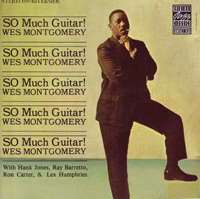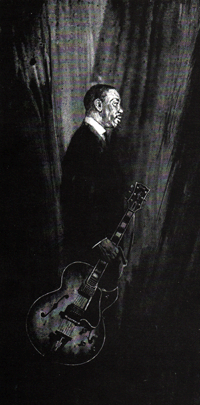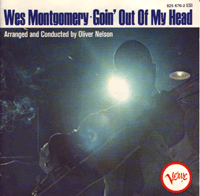Wes Montgomery's
Solos on:
"TWISTED BLUES"(Wes
Montgomery)
Previously, we presented transcriptions of two different Wes Montgomery solos over the same tune. In that case, those solos had been played over Buddy Montgomery's "Bock to Bock." Now, because of the inspiration provided by one my better students, I am able to present both of Wes' recorded solos over his own composition, "Twisted Blues." However, what has proved to be most embarrassing for me, concerning this reinvestigation of the tune, is that I discovered that I had incorrectly written the "solo changes" for it in my book, "The WES MONTGOMERY GUITAR FOLIO"(Gopam). I don't know how I could have thought that Wes was playing over a repeated 16-bar form, when the composition itself is played over an [A][A2] form, with each section being 16 bars long. However, bars 14-15 of [A2] are different, and my lack of attention to that small detail caused my errors. So, my sincere and humble apologies to everyone with the book!
Wes first recorded this tune in 1961 on "SO MUCH
GUITAR"(Riverside) where he was joined by: Hank Jones(Piano); Ron Carter(Ac. Bass); Lex Humphries(Drums); and Ray Barretto(Congas). Here, we offer his 5-chorus solo, all performed in single lines. In 1965, at the height of Wes Montgomery's popularity while recording "GOIN' OUT OF MY HEAD" for Verve, he again recorded "Twisted Blues" as arranged for big band by the brilliant Oliver Nelson. Here, Wes was supported by a rhythm section consisting of: Herbie Hancock(Piano); George Duvivier(Ac. Bass); Grady Tate(Drums); and Candido(Congas). We are only presenting the first two choruses of Wes' solo, the single note portion. In 1965, at the height of Wes Montgomery's popularity while recording "GOIN' OUT OF MY HEAD" for Verve, he again recorded "Twisted Blues" as arranged for big band by the brilliant Oliver Nelson. Here, Wes was supported by a rhythm section consisting of: Herbie Hancock(Piano); George Duvivier(Ac. Bass); Grady Tate(Drums); and Candido(Congas). We are only presenting the first two choruses of Wes' solo, the single note portion.
It is most interesting to note that in the Riverside solo, during the first 8
bars of both [A] and [A2], Wes ignores the G7 chord, which is played in the even
numbered bars. But, in the Verve version, 4 years later, he observes that same G7 chord almost every time. Playing through those bars in Gb7 gives it a more pronounced bluesy feeling. The more time I spend thinking about this tune, the more I believe that, what is really going on, is that the Gb7 chord is really IV7 of the real 'key' of Db major. What also serves to make me believe this is that the G°7 chord which appears at bar 10 of each [A] and [A2] is a most typical blues device that would normally appear in bar 6 of a 12-bar blues. Perhaps this is why Wes saw this tune as a most "twisted" blues?
During the mid-'60s, when I used to trek down to The Lighthouse in Hermosa Beach, California to hear Wes play, between sets, I would occasionally sit with him, and we would talk. In addition, to asking all the typical and unanswerable 'eternal' student's questions, we would talk about his recent recordings. He always would say that playing in front of all the excellent brass, reed and string players made him very nervous, because he felt that his musicianship skills were not on the same level as theirs. Of course, none of those same players could improvise like Wes. So, the trade-off is not such a bad thing. Perhaps, this is why the Verve solo doesn't seem to have the long fluid chromatic lines he played during the Riverside solo? The Verve solo seems to be a bit more rooted in the "blues." And, of course, there is a significant portion of the solo dedicated to the octaves that made him so famous.
Because the tempo, for both solos, is so very bright, Wes does something which many guitarists, whom he has influenced, have adopted, and that is to "sit" on the quarter notes in various passages. This device gives the player a chance to lock-in with the bass before returning to double-time lines. You can see this device in the Riverside solo, Chorus 2 during bars: 2-4; Chorus 3, bars: 7-8 and 23. During the Verve solo this device does appear, albeit briefly, in bar 10 of Chorus 2.
During "Twisted Blues" there are a couple of sequences of non-resolving ii-Vs which begin at bar 12 of both [A] and [A2] and they are:
| Bm7 / E7 / | Bbm7 / Eb7 / | Em7 / A7 / | Ebm7 / Ab7 / | Dm7 / G7 / ||
In [A2] the progression varies slightly, just as it did during the melody:
| Bm7 / E7 / | Bbm7 / Eb7 / | Ebm7 / Ab7 / | Dbmaj7 / / / | Dm7 / G7 / ||
It was very typical of Wes to
negotiate these parallel ii-Vs by playing familiar lines, at least to him, through as many of these
changes as was possible. A key scale degree for Wes was always the 9th of the minor chord. During the Riverside solo, Wes appears to negotiate the changes by linking his lines together, picking-up the next change wherever he left-off on the preceding one. There is a great flow to the improvisation because of this. In the Verve solo, that 9th degree remains as a note of emphasis but, he negotiates the changes by using sequential lines. One might even say that these were 'licks' to Wes. Take note of this in Chorus 1: [A] bars: 12-15; [A2] bars: 28-30. Another great example of this same device appears in Chorus 2: [A] bars: 14-16. And, in Chorus 5 [A] bars: 12-13. picking-up the next change wherever he left-off on the preceding one. There is a great flow to the improvisation because of this. In the Verve solo, that 9th degree remains as a note of emphasis but, he negotiates the changes by using sequential lines. One might even say that these were 'licks' to Wes. Take note of this in Chorus 1: [A] bars: 12-15; [A2] bars: 28-30. Another great example of this same device appears in Chorus 2: [A] bars: 14-16. And, in Chorus 5 [A] bars: 12-13.
It might also serve us well to take a look at how Wes treats the only major 7th chords to appear in the tune. Dbmaj7 appears 3 times in the tune, during [A] at bar 11; and in [A2] at bars 27 and 31. If you listen, and carefully observe, you will see that most times, Wes seems to be 'targeting' his Bb, on the high 'E'-string, and then going straight down the major scale while making smooth transitions to either Bm7, or lastly to Dm7. This happens, believe it or not, 11 times during the Riverside solo!!! In sharp contrast, there is only one moment during the Verve solo where Wes plays something which is reminiscent of this linear configuration.
As this is a 'twisted blues' one would expect some usage of the blues
language from Wes Montgomery. Right from the top of the Riverside solo, Wes is in a bluesy way. I would like to return to the bar with the G°7, bar 10 in each half-chorus, because each time it arrives, and in both solos, Wes treats that bar by either arpeggiating parts of the chord, or using some small part of the appropriate diminished scale. That would be, in this case, a G
whole-tone/half-tone diminished scale(G, A, Bb, C, Db, Eb, E, F#/Gb). You see a greater usage of scale-related elements during the Verve solo. As I stated before, in 'normal' Jazz-oriented 12-bar blues, you often see diminished chords used in bar 6 of the progression. And, often times, players with lots of savvy completely ignore using diminished arpeggios or scale fragments and simply play the blues scale of the main I7 chord. So, in this tune, you could apply the Db blues scale(Db, E/Fb, Gb, G, Ab, Cb). Give this a try and see how you like this approach. During [A2] of Chorus 2 in the Verve solo, you will hear Wes 'riffing' on a double-stop, with a Bb on top from bars 8-11. You see this riff pass right through the °7 chord too. And this is especially interesting, because the Bb is in the diminished scale, but not in the blues scale, but the main notes below are Fb and Db. The Eb is a passing tone, but again, it is part of the diminished scale. More than anything, the application of the blues language has a way of sounding great even when, at times, certain notes are not technically so easily explicable. Some food for thought!
One element I always loved about the way in which Wes constructed his solos was that eventually there would be a moment when he seemed to be using the guitar as a "Big Band." In concept, I suppose that this notion is derived from the "call and response" elements which filtered into "Jazz" from the blues, and by way of the incredible Gospel language. It should not come as a surprise that Wes puts this technique to use during the Verve solo, where he was surrounded by Oliver Nelson's brassy arrangement. In Chorus 2, from bars 4-8, you hear Wes riffing in 3rds with very specific accents, and then answering those 'hits' with bluesy-oriented phrases. As the solo continues, and Chorus 3 begins, he goes into chords with octave punctuations. For Wes, this was a most common and very effective device. Again, he is simply using the guitar as if it were a big band in his hands! Another great example of this type of musical "thinking" appears during the Riverside solo in Chorus 3: [A] bars: 1-6. Here, he answers a simple bluesy idea with gospel/R&B-tinged parallel minor triads[Ebm-Dbm] over Gb7. In concept, I suppose that this notion is derived from the "call and response" elements which filtered into "Jazz" from the blues, and by way of the incredible Gospel language. It should not come as a surprise that Wes puts this technique to use during the Verve solo, where he was surrounded by Oliver Nelson's brassy arrangement. In Chorus 2, from bars 4-8, you hear Wes riffing in 3rds with very specific accents, and then answering those 'hits' with bluesy-oriented phrases. As the solo continues, and Chorus 3 begins, he goes into chords with octave punctuations. For Wes, this was a most common and very effective device. Again, he is simply using the guitar as if it were a big band in his hands! Another great example of this type of musical "thinking" appears during the Riverside solo in Chorus 3: [A] bars: 1-6. Here, he answers a simple bluesy idea with gospel/R&B-tinged parallel minor triads[Ebm-Dbm] over Gb7.
And, please allow me to just say a word or two about Oliver Nelson! As the years have gone by, I have come to appreciate his arranging skills and talents more and more. Though "Twisted Blues" is not the best showcase for the range of his orchestral colors, one can still hear that he was very unique in his usage of the woodwinds. He doesn't simply employ the normal compliment of saxophones. He adds flutes, clarinets, oboe and English horn to create truly unique blends and sonorities. If you happen to already have the Verve recording, you might be wise to investigate some of his other arrangements.
Though presenting two solos, such as this, is extremely labor intensive, I know that, based upon the mail I receive, people just love having access to these wonderful improvisations. I know that they are appreciated and enjoyed all over the world. I know that Wes Montgomery would have been thrilled and overjoyed by this. He was a most wonderful and very humble man. In closing, as we always do at this time of the year, Blaine and I would like to wish everyone the joys of the Holiday Season, a very Merry Christmas, and a most Happy New Year as 2007 dawns. Y por supuesto, ¡Felíz Navidad y Felíz Año Nuevo!!! Wishing you all good health, happiness, and a heapin' helpin' of PEACE everywhere!!! Maybe this year?
[Wes Montgomery and his beloved L-5 in a 1965 Gibson Guitar ad.
From the book, "WES MONTGOMERY" by Adrian Ingram]
|

